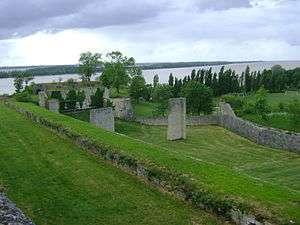Battle of Blaye
| ||||||||||||||||||||||||||||||
The Battle of Blaye of 1593, also known as the Battle of Bec d'Ambès (in French) or Battle of the Gironde Estuary, was a naval Spanish victory that took place on 18 April 1593 off Blaye and Bec d'Ambès, Gironde Estuary, France, during the seven-month siege of Blaye between the French-Protestant forces of Henry of Navarre and the French-Catholic garrison of the city led by Governor Jean-Paul d'Esparbès de Lussan d'Aubeterre, in the context of the French Wars of Religion and the Anglo-Spanish War (1585–1604).[1][2][4][7]
Battle
In April 1593, a Spanish naval force of 16 warships (flyboats and pinnaces) commanded by Admiral Pedro de Zubiaur and General Joanes de Villaviciosa Lizarza set out to relieve Blaye. The city was controlled by the Catholic League of France, but under heavy siege by French Royal troops, supported by English and Huguenot forces, commanded by Marshal Jacques de Goyon d'Matignon, and blocked by sea by six English warship-squadron under Admiral Sir Peter Houghton.[2][8] On 18 April the English naval force was defeated and dispersed by Zubiaur's fleet, and the Spanish troops disembarked at Blaye, relieving the Catholic forces.[2][4][8]
Soon after, another Anglo-French fleet of 11 to 19 warships from Bordeaux, supported by about 40 small vessels (including six galleasses from the port of La Rochelle), arrived at Blaye, trying to block the Spanish fleet.[8] After a fierce and unequal battle, amid an intense storm, the Spaniards were victorious,[9] with significant loss of life on both sides due to heavy musket fire. In the end, many ships of both fleets were dispersed by the storm, and the Spanish fleet managed to return safely to the port of Pasajes.[8][10]
For his part in the fighting, Pedro de Zubiaur was decorated by King Philip II of Spain, receiving the title of "de general como a lo demás de escuadra para que antes que muera deje esto a los míos".[11]
On 14 July the same year another Spanish force, composed of six pinnaces, under the command of Joanes de Villaviciosa Lizarza,[8] and 120 soldiers led by Captain Antonio Manrique de Vargas, sailed from the Basque port of Castro Urdiales, to reinforce the Catholic forces of Blaye.[10][12] After the Spanish troops under Villaviciosa launched a successful assault against the Protestant positions, which resulted in over 800 Protestants killed or wounded,[12] the siege finally ended with the withdrawal of the French-Protestant troops.[4][10][13]
See also
- Battle of Craon
- Battle of the Bay of Biscay (1592)
- Siege of Fort Crozon
- Battle of Cornwall
- French Wars of Religion
- Catholic League of France
Notes
- 1 2 Armada española desde la unión de los reinos de Castilla y Aragón. Vol III. Fernández Duro p.85
- 1 2 3 4 5 6 En el IV Centenario del fallecimiento de Pedro Zubiaur, un marino vasco del siglo XVI. Gracia Rivas p.163
- 1 2 3 4 5 Fernández Duro p.85
- 1 2 3 4 Gustav Ungerer p.53
- 1 2 3 4 Historia General de España. Vol. VII. Ortiz y Sanz p.43
- ↑ Al ruido de la artillería bajaron de Burdeos 19 navíos con otros menores de Broage, que llegaban en suma 60 velas, tratando de cerrar el paso y envolver a los españoles, para lo que mucho hicieron seis galeazas de la Rochela apoyando al capitán Lallmiraille, jefe superior. Fernández Duro p.85 (Spanish)
- ↑ Ortega y Medina p.200
- 1 2 3 4 5 Duro p.85
- ↑ Rivas p.163
- 1 2 3 Ortiz y Sanz p.43
- ↑ Fernández Duro p.86
- 1 2 Fernández Duro pp.86–87
- ↑ Con esta brillantísima acción se levantó el sitio, que duraba ya siete meses, quedando las pinazas al abrigo de los cañones del fuerte hasta el 4 de Agosto en la noche, aprovechada por Villaviciosa para dar otro golpe audaz. Fernández Duro p.86 (Spanish)
References
- Fernández Duro, Cesáreo (1898). Armada Española desde la unión de los reinos de Castilla y Aragón. Vol. III. Madrid. (Spanish)
- José Ortiz y Sanz. Historia General de España. Vol. VII. Third Edition, Madrid (1846). (Spanish)
- Gustav Ungerer. A Spaniard in Elizabethan England: The Correspondence of Antonio Pérez's Exile. Vol. I. London 1974. ISBN 0-900411-84-8
- Mac Caffrey, Wallace T. (1994). Elizabeth I: War and Politics, 1588–1603. Princeton. Princeton University Press. USA. ISBN 978-0-691-03651-9
- Ortega y Medina, Juan Antonio. El conflicto anglo-español por el dominio oceánico. Universidad Nacional Autónoma de México. 1994. ISBN 968-58-0150-9 (Spanish)
- Gracia Rivas, Manuel. En el IV Centenario del fallecimiento de Pedro Zubiaur, un marino vasco del siglo XVI. Itsas Memoria. Untzi Museo Naval. San Sebastián 2006. (Spanish)
External links
- José Ortiz y Sanz. Historia General de España. Vol. VII. Battle of Blaye 1593. (Spanish)
